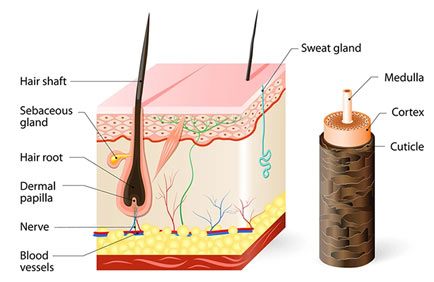Introduction
Thread-like strands growing from the skin of organisms like mammals, humans, or any other animal is called hair. Hair is a keratinized modification of the stratum corneum – the outermost layer of the epidermis.
Hairs are sensitive tactile organs that have an insulating and protective effect. Hairs have sensory nerve endings in their roots. That is why on the displacement of hairs, the root initiates a wave of sensory impulses to the brain.
- Vibrissae are the long stiff whiskers present on the face of many mammals that are highly sensitive.
Mammalian hair varies from species to species, between one area of the body to another, from one season to another, or in different age groups. Hairs develop in different groups of two or dozens.
Structure of Hair
Each hair consists of three parts
- Shaft
- Root
- Bulb
The Shaft
The shaft lies free within the follicle and projects above the surface. The shaft is composed of layers of keratinized cells numbering 500,000/ linear inches. The shaft commences just beneath the openings from the glands. It is surrounded by sebum in the follicle.
The Root
It is the part of the hair deep in the follicle. Here it is yet not separated from surrounding epidermal cells. The cells are keratinized and dead.
The Bulb
The bulb is basically a swelling at the base of the follicle containing the dermal papilla. Here mitosis is occurring rapidly and new cells are constantly produced to make hair long. The dermal papilla is richly supplied with blood vessels and provides nutrients and oxygen for growth.
A single hair is composed of keratin, trapped air vacuoles, and different amounts of a pigment called melanin. Melanin is taken from dermal pigment cells and gives brown and black shades in various concentrations. Another related pigment causes reddish tinges in the hair.
Each hair is surrounded by a thin layer of the cuticle which consists of transparent, cornified cells that often overlap in a scale-like fashion.
Arrector pili
A smooth muscle called arrector pili is present on the walls of hair follicles. When this muscle contracts the hair becomes erect and skin around the hair is pulled into a heap causing “gooseflesh” or “chill bumps”.
- Elevation of hairs in many mammals symbolized their anger.
Development of Hair
Hairs develop from the hair follicle that goes deep into the dermis. First of all, the hair follicle is formed as cylindrical ingrowth of the dermis into the epidermis. A dermal papilla organizes the epidermal ingrowth. It has no mesodermal tissues.
Epidermal cells divide and grow continuously at the same time the hair primordium grows deeper and deeper into the dermis. The dermal papilla is rich with blood vessels to supply food and oxygen for nourishment and growth.
After the differentiation of the bulb at the base of the primordium, the cornified (keratinized) cells start to appear and the hair shaft rises out of the follicle.
Modification of Hair
During evolution, hairs are modified into a variety of structures such as
- Horns rhinoceros may be the evolutionary product of Agglutinated hair.
- Scales of Pangolin
- Bristles
- Porcupine quills
- Species of spiny anteater

